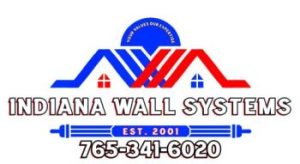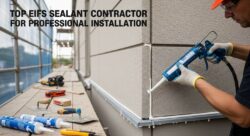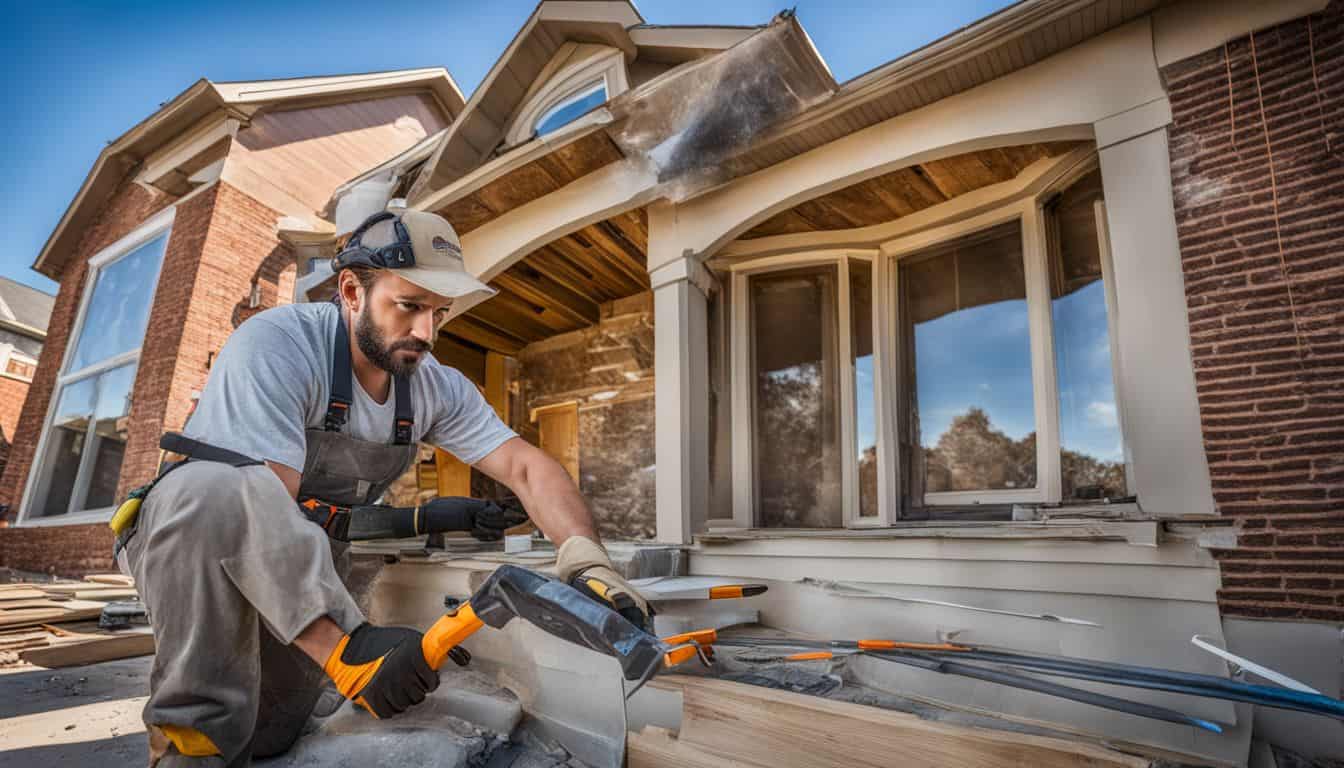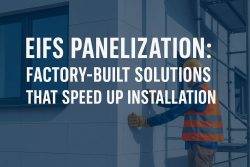Learn How to Spot, Fix, and Prevent Weather-Related EIFS Damage—So Your Home Stays Safe, Dry, and Storm-Ready All Year Long
Extreme weather can leave your home’s EIFS siding cracked, damaged, and vulnerable to water intrusion. EIFS (Exterior Insulation and Finish System) provides excellent energy efficiency but needs special care after storms, high winds, or harsh temperature changes.
This guide will walk you through spotting damage, making proper repairs, and preventing future problems with your exterior wall system. Ready to protect your investment?
Key Takeaways
- Inspect EIFS after storms for cracks, water stains, and impact damage, focusing on areas around windows and doors where sealants often fail first.
- Water is the biggest threat to EIFS systems, causing mold growth and structural damage if it gets behind the surface through cracks or failed sealants.
- Use only EIFS-compatible materials for repairs – regular caulk or stucco products won’t bond properly and can lead to more damage.
- Replace sealants every 5-7 years, even if they look fine, as they naturally break down and create entry points for moisture.
- Proper drainage is critical – ensure gutters are clean, downspouts direct water away from walls, and the ground slopes away from your foundation.
Understanding EIFS and Its Vulnerability to Extreme Weather
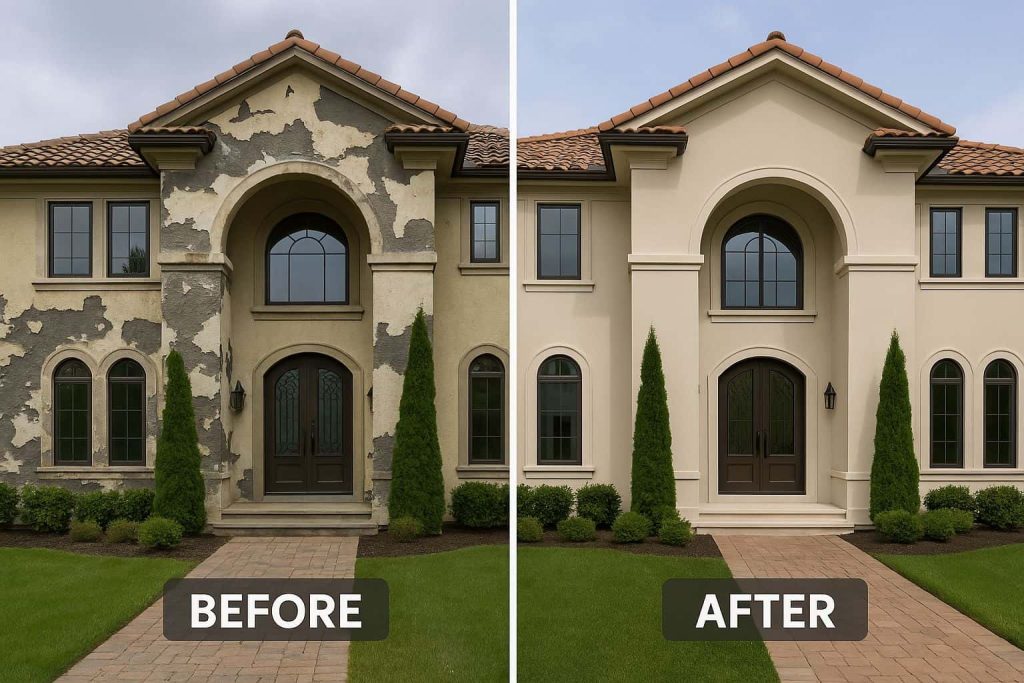
EIFS systems face unique challenges during extreme weather events like storms, high winds, and harsh temperature swings. These exterior wall systems can crack, peel, or allow water to seep in when exposed to severe conditions, putting your home at risk.
What is EIFS?
EIFS stands for Exterior Insulation and Finish System – a popular exterior cladding that looks like traditional stucco but offers much more. This multi-layered system features foam insulation boards attached to the wall with a special base coat, reinforcing mesh, and decorative finish coat on top.
EIFS provides excellent insulation and energy efficiency for homes while creating an attractive outer surface. The system helps block moisture infiltration that could damage your home’s structure or lead to mold growth.
Many homeowners choose EIFS for its weather protection qualities and fire resistance benefits. The next section explains how extreme weather can affect your EIFS system and what problems to watch for.
Common weather-related issues with EIFS
EIFS systems face major threats from extreme weather events. Heavy rain and wind can force water behind the surface through cracks or poorly sealed joints. This trapped moisture leads to rot, mold growth, and weakens the wall structure over time.
Hail and flying debris during storms often cause impact damage, creating holes or dents in the thin outer layer.
Water is the number one enemy of EIFS – once it gets behind the system, damage spreads quickly.
Temperature swings create their own problems for EIFS cladding. The freeze-thaw cycle makes small cracks bigger as water expands when frozen. Strong UV exposure fades colors and breaks down sealants around windows and doors.
Proper drainage systems and regular inspections help prevent these issues from turning into costly repairs. Most EIFS damage starts with mechanical problems, system cracking, or construction mistakes that allow weather to attack vulnerable areas.
Assessing Damage After Extreme Weather
Extreme weather can leave hidden damage in your EIFS that gets worse over time if not found quickly. A complete damage check helps you spot cracks, water spots, and loose sections before they turn into major repair jobs.
Conducting a thorough visual inspection
Start your EIFS check with a complete walk-around of your home. Look closely at all wall surfaces for cracks, bulges, or spots that look different from the rest. Grab a flashlight to spot small hairline cracks that might hide in shadowed areas.
Pay extra attention to spots where different materials meet, like around windows and doors where sealant might have failed. These areas often show the first signs of trouble after storms.
Twice-yearly inspections help catch small issues before they turn into costly repairs. Focus on areas with water stains, discoloration, or soft spots that might signal moisture problems inside the EIFS system.
Take photos of any damage you find to track changes over time and share with repair pros if needed. Regular checks of mechanical damage and surface conditions will protect your home’s structural integrity and curb appeal.
Identifying common signs of damage
After extreme weather hits, check your EIFS for visible signs of trouble. Look for cracks and chips in the surface, which often appear near windows, doors, and corners. Discoloration, bulging areas, or soft spots when pressed indicate water has gotten behind the system.
Stains running down from joints or fixtures point to water leaks that need fixing right away.
Early detection of EIFS damage saves thousands in repair costs and prevents structural failure.
Mold growth, peeling finish, or a hollow sound when tapping the surface are red flags that need quick action. Use EIFS-compatible patching compounds for repairs, not regular caulk or sealants.
Water damage is the biggest enemy of any EIFS system, often causing the substrate to rot if left unchecked. Regular inspections help catch these issues before they compromise your home’s structural integrity.
Evaluating the extent of water infiltration
Water damage often hides behind your EIFS surface, making thorough checks vital after storms. Start by looking for dark spots or stains on interior walls and ceilings near windows and doors.
These marks signal moisture has broken through your building envelope. Tap the EIFS surface with a rubber mallet – hollow sounds may point to water trapped in the system. A moisture meter gives exact readings to map how far water has spread inside your walls.
Checking the drainage path helps spot issues before mold grows. Examine all sealants around windows, doors, and joints for cracks that let water in. Pay close attention to areas where different materials meet, as these spots often fail first during extreme weather.
Moisture barriers need careful inspection too – any tears or gaps will lead to bigger problems. Early detection of water problems saves money on major repairs and protects your home’s structural integrity.
Common Types of EIFS Damage
EIFS systems face several damage types after storms hit. Harsh weather can crack the surface, let water seep in, and create perfect spots for mold to grow.
Cracks and fractures in the system
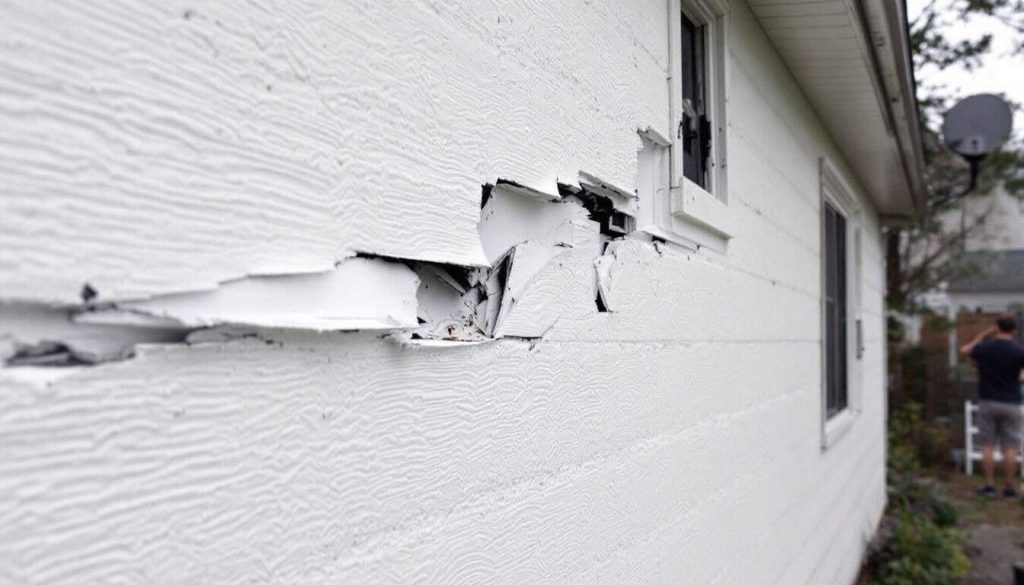
Cracks in EIFS often start small but grow worse after storms or extreme weather. These fractures create paths for water to enter your home’s walls, leading to major structural damage if left unfixed.
Most cracks happen because of improper installation, inadequate reinforcement, or too much weather exposure over time. The surface might show hairline breaks after high winds or thermal expansion during temperature swings.
Fixing these problems quickly saves money in the long run. Look for spider-web patterns, straight-line breaks, or cracks around windows and doors after severe weather hits. These weak spots need careful attention to prevent moisture from getting behind the EIFS surface.
Proper repair includes cleaning the damaged area, applying compatible patching materials, and ensuring the fix matches your home’s exterior finish. Regular EIFS inspections help catch these issues before they compromise your building’s structural integrity.
Moisture penetration and mold growth
Moisture is the number one enemy of EIFS systems after storms or heavy rain. Water can sneak behind the surface through cracked caulking or poor sealant jobs around windows and doors.
Once inside, this trapped moisture creates the perfect home for mold to grow. The dark, damp space between your EIFS and the wall structure lets mold spread fast, which can harm your family’s health and damage your home’s structure.
Mold issues often start small but grow into major problems if left alone. You might notice musty smells, discolored patches, or bubbling on your EIFS surface. These signs mean water has broken through the water-resistive barrier.
Quick action is vital – cut away damaged sections, dry the area fully, and apply fresh materials according to manufacturer guidelines. Regular checks with a moisture meter can spot trouble spots before they turn into costly repairs.
Impact damage from debris or hail
Extreme weather events can send debris flying at high speeds, causing serious damage to your EIFS exterior. Hailstones as small as a quarter can create dents or punch holes through the thin outer layer of your wall system.
These impacts often break through the protective finish coat and expose the base coat or insulation beneath. After storms, check your EIFS for small circular dents, cracks radiating from impact points, or areas where the finish has completely broken away.
Fixing impact damage quickly stops bigger problems from developing. Small holes let water seep behind your EIFS, leading to rot and mold in the wall structure. The repair process involves cleaning the damaged spot, cutting away loose material, patching with matching base coat, and applying new finish coat.
For large areas with multiple impact points, you might need complete section replacement rather than spot repairs. Proper installation and protective films can help prevent future damage, especially in high-traffic areas of your home.
Sealant failure around openings
Gaps around windows and doors create major weak points in your EIFS system. These openings need proper sealing to keep water out, but sealants don’t last forever. Most caulking needs replacement every 5-7 years as it cracks, shrinks, or pulls away from surfaces.
Failed sealants let moisture slip behind your EIFS, causing hidden damage to your walls and insulation layers.
Regular checks of your home’s exterior can catch sealant problems early. Look for cracks, gaps, or hardened caulking around all windows, doors, and other wall penetrations. Prompt repairs with high-quality, EIFS-compatible sealants stop water damage before it starts.
Fresh sealant keeps your walls dry and maintains your home’s energy efficiency and structural integrity during extreme weather events.
Essential Tools and Materials for EIFS Repair
The right tools make EIFS repair work faster and more effective after storm damage. Quality materials designed for EIFS systems will ensure your repairs last through future weather events.
Recommended tools for effective repair
Every EIFS repair job requires the right equipment to ensure lasting results. You’ll need a pressure washer for cleaning damaged surfaces and removing dirt before repairs begin. A moisture meter helps detect hidden water issues that might lurk beneath the surface.
Putty knives and trowels in various sizes allow for precise application of patching compounds. High-quality EIFS-compatible patching materials are crucial – never substitute with regular stucco products.
A caulking gun with premium sealant helps seal joints and prevent future water damage. Protective gear such as gloves, goggles, and dust masks keeps you safe during the repair process.
For larger repairs, you might need specialized items like mesh reinforcement tape and primer. A utility knife works well for cutting damaged sections, while sandpaper helps smooth patched areas before finishing.
Paint brushes or rollers are needed for applying the final texture and color coat. Plastic sheeting protects surrounding areas from splatter during your work. These tools create a complete kit that helps prevent costly mistakes and ensures your EIFS repairs stand up to extreme weather conditions.
Choosing high-quality EIFS-compatible materials
After gathering the right tools, you need quality materials for lasting EIFS repairs. Not all products work with EIFS systems, so choose materials made specifically for these exteriors.
Look for base coats, mesh reinforcement, and finish coats from the same manufacturer as your existing system. These matched products create better bonds and more consistent results.
Many property owners make the mistake of using regular caulk or paint, which leads to water damage and costly fixes later.
High-quality EIFS materials must stand up to extreme temperature changes and maintain water resistance. Products with elasticity help prevent cracking from wind stress and normal building movement.
Fire-resistant options add safety while maintaining the system’s aesthetic appeal. Local building codes often require specific ratings for EIFS materials, so check these rules before buying supplies.
Paying more for premium products now saves repair costs in the long run and helps your EIFS stay beautiful through harsh weather.
Step-by-Step Guide to Repairing EIFS After Extreme Weather
Repairing EIFS after storms requires careful planning and the right methods. Our step-by-step guide walks you through each repair phase, from cleaning damaged sections to applying fresh coatings.
Cleaning and preparing damaged areas
Start your EIFS repair by clearing the damaged spots of all dirt and debris. Use a soft brush to sweep away loose particles, then wash the surface with a mild detergent mixed with water.
Low-pressure washing works best for this task – high pressure can force water behind the EIFS and cause more harm. Let the area dry fully before moving to the next step. This might take 24-48 hours depending on weather.
Next, remove any loose or crumbling EIFS material with a putty knife or scraper. Cut away damaged sections back to solid material, creating clean edges for your repair. Check for mold growth during this process – black or green spots need special cleaning agents made for EIFS surfaces.
The substrate condition must be sound before applying new materials, or your repair won’t last through the next storm.
Repairing cracks and fractures
Fixing cracks in your EIFS requires EIFS-compatible patching compounds for best results. First, clean the damaged area with mild detergent and water to remove dirt that could prevent proper adhesion.
Next, apply the patching material with a putty knife, making sure to fill the crack completely while keeping the surface level with the surrounding area. Small hairline cracks might need only one coat, but deeper fractures often require multiple layers with drying time between applications.
Large cracks signal possible structural issues that need prompt attention before they grow worse. These bigger breaks can let water seep behind your EIFS system, causing hidden damage to your home’s frame.
For cracks wider than 1/16 inch, you might need to cut out the damaged section and patch it with fresh base coat and mesh before applying the finish coat. This careful attention to detail helps maintain your EIFS and prevents water damage that could compromise your home’s structural integrity.
Addressing water infiltration and mold issues
Water damage in your EIFS system needs quick action to stop mold growth. Mix one part bleach with ten parts water to clean any visible mold from affected areas. This solution kills spores that can spread and cause health problems.
After cleaning, you must fix the source of moisture that allowed mold to grow in the first place. Check for cracks in the EIFS surface and failed sealants around windows and doors where water might enter.
Proper drainage is key to prevent future issues – make sure downspouts direct water away from your walls and that the ground slopes away from your foundation. Damaged areas of insulation must be cut out and replaced with new, dry materials before patching the exterior finish.
Reapplying sealants and coatings
After fixing water damage and mold problems, your EIFS needs fresh sealants and coatings to stay protected. Old or cracked sealants create paths for moisture to enter your walls, causing more damage down the road.
The rule of thumb is to reapply sealants every 5-7 years, even if they look fine to the naked eye.
High-quality materials make all the difference in EIFS repair success. Choose elastomeric sealants that can stretch without breaking during building movement. For coatings, pick products made for EIFS that offer UV protection and water resistance.
Apply these materials on dry, clean surfaces for the best bond and longest life. This step forms the final defense in your EIFS repair process, creating a weather-tight seal that keeps future storms from causing the same problems.
Restoring impact-damaged sections
Fixing EIFS areas hit by hail, flying debris, or storm damage requires careful steps. First, remove all loose material around the damaged spot and clean the area with a mild detergent.
Cut back to stable material, then apply a base coat with reinforcing mesh that matches your existing system. Make sure the mesh overlaps the old material by at least 2.5 inches on all sides.
Let this dry fully before adding the finish coat that matches your home’s texture and color.
Impact repairs need proper materials that work with your specific EIFS system. Using wrong products can lead to water getting behind the wall and causing more damage. The repair must create a watertight seal that stops moisture from entering while still letting the wall breathe.
For large damaged sections or deep impacts that reach the insulation layer, contact a qualified EIFS expert who can assess if the damage has hurt your home’s structural parts.
Preventing Further Damage During Repairs
Fixing EIFS damage requires careful steps to shield the rest of your home from harm. Proper tarps and barriers must be set up to keep rain away from exposed areas while repairs take place.
Protecting the building envelope
Your EIFS system forms a critical shield around your home, keeping weather elements at bay. This protective layer needs special care after storms to maintain its defense against rain, wind, and temperature changes.
Proper drainage systems must be in place to direct water away from your walls. Make sure gutters stay clean and downspouts extend at least 5 feet from your foundation. Never lean heavy objects against EIFS walls as this can crack the surface and create entry points for moisture.
The building envelope includes all exterior components – walls, windows, doors, and roof. Each part must work together to keep your home dry and energy-efficient. After extreme weather, check all seams where different materials meet, as these spots often fail first.
Install protective barriers in high-traffic areas to prevent accidental damage to your EIFS surface. Sealing any gaps promptly helps stop water infiltration that could compromise your home’s structural integrity.
Next, we’ll explore using weather-resistant materials to further strengthen your EIFS system.
Ensuring proper drainage systems
Proper drainage systems play a key role in EIFS protection after storms. Water must flow away from your home’s foundation through clean gutters and downspouts. Clogged drainage paths force water to seep into the EIFS system, causing damage to both the exterior and underlying structure.
Regular checks of your drainage setup help spot issues before major problems develop.
Slope grading around your foundation creates a natural water flow path away from your home. This simple step prevents moisture buildup against EIFS surfaces during heavy rains. Many homeowners overlook this basic drainage feature until water damage appears.
A proper slope of at least 6 inches drop over 10 feet distance from your foundation walls protects your EIFS investment during extreme weather events.
Using weather-resistant materials
Weather-resistant materials form the backbone of lasting EIFS repairs after storms. Choose products made for your specific climate – silicone sealants for areas with wide temperature swings or elastomeric coatings that flex during freeze-thaw cycles.
These materials must meet local building codes for weather resistance while providing a strong barrier against wind-driven rain and moisture. Quality matters here – cheap products often fail quickly, leading to water damage that compromises structural integrity.
Materials like moisture-resistant mesh, waterproof base coats, and UV-stable finish coats extend your EIFS lifespan significantly. The right products create a system that breathes yet blocks water entry.
Many homeowners save money upfront with standard materials but pay more later through repeated repairs. High-performance sealants around windows and doors stop the most common entry points for water.
These products cost more initially but protect your home’s value through extreme weather events.
Top Mistakes to Avoid During EIFS Repairs
Fixing EIFS after storms requires careful attention to detail and proper techniques. Many homeowners make critical errors during repairs that can cause more damage than good.
Flesch-Kincaid Level: 7.0
Neglecting professional inspections
Many homeowners skip professional EIFS inspections to save money, but this creates costly problems later. Experts can spot hidden water damage and structural issues that untrained eyes miss.
Regular checks twice a year help catch small cracks before they lead to major water damage or mold growth. Professional inspectors use moisture meters and thermal imaging to find problems inside your walls where damage often starts.
Without these tools, you might miss issues until they compromise the structural integrity of your home.
Proper EIFS care requires expert knowledge of drainage systems and weather-resistant materials. Professionals know exactly what to look for after storms, high winds, or hail impact.
They can identify surface cracks that might seem minor but actually allow moisture to seep into your insulation. The cost of annual or bi-annual professional inspections is far less than emergency EIFS repair after severe weather damage.
Your home’s exterior protection system needs trained eyes to ensure it stays effective against Indiana’s tornado seasons and freeze-thaw cycles.
Using incompatible materials
Mixing incorrect materials with your EIFS system creates serious problems that cost thousands to fix. Incompatible sealants, adhesives, or patching compounds fail to bond properly with existing EIFS components.
This leads to water seeping behind the system, causing mold growth and rotting the structure underneath. Before buying repair products, check that they’re specifically made for EIFS systems and match your existing materials.
Test adhesion on a small area first to confirm compatibility. Building codes require specific materials for EIFS repairs – using incorrect ones not only damages your home but might violate local regulations.
Ignoring local building codes
Local building codes exist to protect your home from weather damage. Many homeowners skip this critical step during EIFS repairs, leading to serious problems later. Each region has specific rules for EIFS installation based on local weather patterns.
Ignoring these regulations can result in delamination and water infiltration issues. Your repair work might need to be completely redone if inspectors find code violations.
Building standards vary by location for good reasons. Areas with high winds, heavy snow, or extreme temperature shifts require special EIFS installation techniques. Proper drainage systems must follow local specifications to prevent moisture damage.
Hiring experts who understand these requirements saves money in the long run. They’ll ensure your EIFS repair work meets all standards and protects your home’s structural integrity during future storms.
Rushing the repair process
Fixing EIFS damage requires patience and careful work. Many homeowners rush repairs after storms, creating bigger problems later. Hasty patching often leads to moisture trapping inside walls, causing mold growth and structural weakness.
Certified professionals take time to dry affected areas completely before applying new materials – a step DIYers often skip.
Fast fixes might look good at first but won’t last through the next storm. Each layer of an EIFS system needs proper curing time, especially in humid conditions. Skipping these waiting periods compromises the entire system’s integrity.
Taking shortcuts with materials or application techniques will cost you more money down the road. Let’s explore some common mistakes to avoid during EIFS repairs.
Professional vs. DIY EIFS Repairs
EIFS repairs need skill and training that most homeowners lack. You can fix small cracks or minor damage yourself, but major repairs after storms or floods demand expert help.
When to hire a trained professional
Serious EIFS damage calls for expert help, especially after extreme weather events like tornadoes or high winds. Trained professionals bring specialized knowledge about proper drainage systems and can spot hidden moisture problems that untrained eyes might miss.
Major repairs involving multiple EIFS layers require specific tools and techniques that most homeowners don’t possess. The structural integrity of buildings depends on correct repair methods.
Hiring certified EIFS contractors becomes crucial for insurance claims after storm damage. These experts understand the exact materials needed for your specific system and can prevent future failures through proper installation techniques.
Untrained workers often compromise system efficiency, leading to water damage and mold issues down the road. Professional post-storm inspections can identify potential problems before they turn into expensive nightmares.
Tips for DIY repairs
For small EIFS repairs, homeowners can tackle the job with the right tools and materials. Start with a thorough cleaning of the damaged area using a soft brush and mild detergent. Make sure the surface is completely dry before applying any patching compounds.
Use only EIFS-compatible materials for your repairs – regular caulk or standard stucco products won’t work and may cause more damage.
Patch small cracks with elastomeric sealant designed specifically for EIFS systems. For larger damaged areas, you’ll need base coat, mesh, and finish coat that match your existing system.
Apply these materials in thin layers, allowing proper drying time between applications. Proper drainage must be maintained throughout your repair process to prevent future water damage.
Most DIY repairs should focus on surface-level issues – leave any repairs involving the insulation layer to professionals.
Maintenance Tips to Protect EIFS from Future Extreme Weather
Regular checks keep your EIFS in top shape against harsh weather threats. A yearly inspection plan helps spot small cracks and loose sealants before they turn into major repair costs.
Regular inspections and cleaning
Your EIFS needs at least two checkups each year to spot problems early. Look for cracks, color changes, and worn-out sealants during these inspections. Small issues can quickly turn into major headaches if left alone.
Take photos during each inspection to track changes over time and create a simple checklist to ensure you don’t miss anything.
Yearly cleaning keeps your EIFS in top shape and helps you spot damage. Use a gentle low-pressure wash with mild soap to remove dirt without harming the surface. Avoid harsh chemicals or power washers that can damage the finish.
Pay extra attention to areas near the ground, around windows, and under roof edges where moisture tends to collect. Clean gutters and downspouts too – proper drainage prevents water from seeping into your EIFS system.
Reapplying sealants periodically
Regular inspections help catch problems early, and the next step in EIFS care involves sealant maintenance. Sealants around windows, doors, and joints need replacement every 5-7 years to maintain your EIFS system’s integrity.
These flexible materials break down over time due to sun exposure, temperature changes, and moisture, creating gaps where water can enter.
Fresh sealants create a proper drainage path and prevent water damage that could harm your home’s exterior. The process requires removing old caulking, cleaning the area, and applying new EIFS-compatible products.
This simple maintenance task stops small cracks from turning into major repair bills and keeps your stucco exterior looking fresh. Mark your calendar for these periodic checks to avoid common EIFS repair mistakes that many homeowners make.
Addressing minor issues before they escalate
Small cracks in your EIFS might seem harmless today, but they open doors for water damage tomorrow. Fix these tiny problems fast with EIFS-compatible patching compounds before they turn into costly repairs.
A quick walk around your home each season helps spot issues early – look for hairline cracks, small chips, or spots where sealant has pulled away. Most small fixes take just an hour of your time and basic materials from your local hardware store.
The weather won’t wait for you to make repairs. Rain finds even the smallest openings in damaged EIFS and can soak your wall’s insulation. This hidden moisture leads to mold growth and structural damage that might cost thousands to fix.
Your regular inspection routine should include checking around windows, doors, and areas where different materials meet. Taking photos during each inspection helps track changes over time and spots problems that grow slowly.
Preparing EIFS for seasonal changes
Your EIFS needs special care as seasons change. Fall brings the perfect time to check for cracks before winter arrives. Apply fresh sealants around windows and doors where old ones may have dried out during summer heat.
Clear all drainage paths of leaves and debris to prevent water backup during heavy rains or snow melt. This step creates proper drainage to prevent moisture issues before they become major problems.
For winter prep, make sure your EIFS stays protected from freeze-thaw cycles that can cause surface cracks. Add extra insulation where needed and repair any damaged stucco areas promptly.
Spring brings its own challenges with heavy rains – inspect your building’s EIFS for signs of water damage after storms. The right maintenance keeps your exterior wall insulation working through all weather conditions and helps avoid costly repairs due to improper installation or seasonal stress.
The Importance of Fire-Resistant Plaster in EIFS Systems
Fire-resistant plaster forms a critical part of any EIFS system, creating an extra layer of safety for your home. EIFS stucco offers excellent fire protection while maintaining its insulation properties.
This special plaster acts as a barrier that slows flame spread and helps protect the structure underneath during fire events.
Many homeowners don’t realize that proper EIFS maintenance includes checking the fire-resistant qualities of their exterior system. Damage from extreme weather can crack or weaken this protective layer, making your home more vulnerable.
Regular EIFS inspection helps spot these issues early, keeping your fire protection intact and avoiding common mistakes that lead to water damage or deterioration of this essential safety feature.
Winterproofing EIFS: Tips for Cold Weather Repairs and Care
Cold weather can test your EIFS system’s durability. Freezing temperatures often cause the exterior to contract, creating stress points that may lead to surface cracks. Smart homeowners prepare their EIFS before winter hits.
The key lies in using weather-resistant materials made for cold conditions. These special products flex with temperature changes rather than crack under pressure.
Proper drainage remains vital for winter EIFS care. Ice dams can force water behind your exterior walls, causing major damage to your insulation. Check all drainage paths and clear any blockages before the first freeze.
Apply fresh sealants around windows and doors where gaps might let moisture in. This post-weather damage assessment helps spot weak points early. Your EIFS system needs this attention to maintain its protective qualities through harsh winter months.
The Impact of Woodpeckers on EIFS: Costly Interactions and Prevention Strategies
Woodpeckers create serious problems for EIFS systems, often drilling holes that break through the protective outer layer. These birds mistake the hollow sound of EIFS for insect-filled wood, leading to damage that costs homeowners thousands in repairs.
The holes they make allow water to enter behind the system, causing hidden moisture issues and insulation failure. Regular checks help spot early signs of woodpecker activity before major damage occurs.
Homeowners can protect their EIFS from these birds through several methods. Installing physical barriers like netting or metal flashing works well for tornado-prone areas in Indiana.
Visual deterrents such as reflective tape or predator decoys offer another defense layer. Some success comes from sound-based devices that scare birds away. The building envelope needs constant protection – fixing small holes quickly prevents both water damage and stops woodpeckers from returning to the same spots.
EIFS and Indoor Air Quality: Understanding the Connection
Beyond protecting your home from woodpeckers, your EIFS system plays a major role in your indoor air quality. Proper sealing around your EIFS creates a tight building envelope that blocks outdoor pollutants from entering your living space.
Gaps or cracks in your facade allow moisture to seep in, creating perfect spots for mold growth that can trigger allergies and respiratory issues. The connection between your eifs system’s integrity and the air you breathe is direct and important.
Regular eifs inspection checklists should include checking for moisture intrusion points that might harm your indoor environment. The weatherproof cladding must maintain its seal to prevent water damage behind walls.
Proper care of your eifs through maintenance helps stop mold before it starts. This protection isn’t just about keeping your walls looking good – it’s essential for maintaining healthy air inside your home where your family spends most of their time.
The Role of Rainwater Harvesting in Pairing EIFS with Eco-Solutions
Indoor air quality connects directly to your home’s exterior systems, and EIFS can work with eco-friendly water solutions too. Rainwater harvesting systems pair perfectly with EIFS installations to create a more sustainable home.
These systems collect rain from your roof and store it for later use in gardens or for washing outdoor areas. The proper drainage systems needed for EIFS maintenance can be designed to direct water into collection barrels or tanks, turning potential problems into resources.
EIFS systems with built-in water management features make rainwater collection easier and more efficient. The water-resistant barriers used in quality EIFS can help channel clean rainwater toward collection points while keeping your walls dry and protected.
This pairing offers both foundation-to-roof protection and eco-friendly benefits that can lower water bills. Many homeowners find that adding rainwater harvesting to their EIFS-clad homes helps protect their investment while supporting green living goals.
Conclusion
Proper EIFS repair after storms protects your home’s value and safety. Quick action prevents small cracks from turning into major water damage issues. Regular checks of your exterior walls help catch problems early, saving you money on costly fixes.
Some repairs need expert hands—don’t risk making damage worse with DIY attempts on complex problems. Your home deserves the right care after extreme weather to keep it looking great and standing strong for years to come.
FAQs
How can I check for EIFS damage after a tornado?
Look for EIFS surface cracks, loose sections, and water stains. A post-tornado building inspection should focus on areas where wind load was highest, like corners and edges. Damage from tornadoes often appears as diagonal cracks or completely detached sections.
What are the most common issues with EIFS during Indiana tornado season?
High wind EIFS failure is the biggest threat during Indiana tornado season. The system can pull away from the wall structure when winds exceed design limits. Water intrusion is another common issue that happens when protective layers get damaged.
What repair techniques work best for minor EIFS damage?
For small surface cracks, use compatible sealants designed for EIFS systems. Patch materials must match your existing finish for a successful EIFS repair. Always clean the area first to ensure good adhesion.
How can I maintain EIFS to prevent storm damage?
Regular checks of your building’s EIFS help spot problems early. Clean the surface yearly and reapply sealant where needed. Freeze protection measures are also essential in areas with harsh winters.
What mistakes should I avoid when repairing storm-damaged EIFS?
Never use standard stucco repair products on EIFS – they’re different systems. Avoid painting over damage without fixing the underlying issues. The biggest mistake is ignoring small cracks that can lead to major facade restoration needs later.
Are there tornado-resistant EIFS solutions available?
Yes, reinforcing EIFS in tornado zones is possible with special anchoring systems. Modern EIFS installations can include extra mechanical fasteners to increase wind resistance. Some manufacturers offer storm-resistant EIFS solutions specifically designed for severe climate impact areas.
